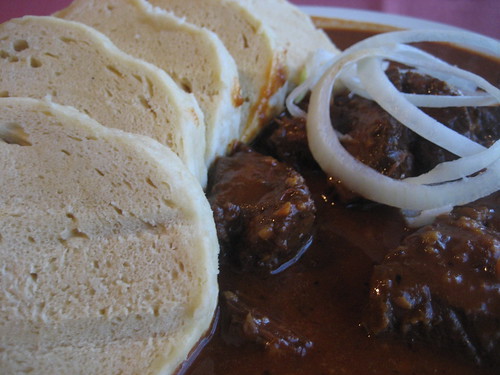You may not feel the need to read another why-newspapers-are-dying piece— one example of how Big Journalism is out of touch with its readers is how much more fascinated it is with its own demise than they are— but you should read Whet Moser’s entry in the Reader, which is much more practical and down to earth than most.
Unlike a lot of me-hate-bloggers professionals, Moser accurately understands why blogging and other forms of online activity have eaten Big Journo’s lunch: “Some of these people writing for free are better at writing than many of the people who are paid to write… Traditional journalism, in 2009 AD, is boring and kind of uninformative.”
This is cruel but true enough. Partisan, passionate, snarky, occasionally fearsomely well-informed bloggers have written rings around much of journalism. There are two reasons for this, one of which Moser sees, one he doesn’t, quite. The first is because sometimes, they are the very experts who, in past days, journalists would have called for a quote. In that case journalism is just another middleman displaced by the internet. No, the average 22-year-old spouting off about the Supreme Court may not know what he’s talking about, but it’s a safe bet Richard Posner does, and when you can read Posner directly, you don’t need the newspaper reducing him to a “but critics say” soundbite in some reporter’s piece. The clueless 22-year-old loudmouth is merely a side effect of the freedom that makes Posner’s blog possible, and easily ignored.
In every area where I’ve abandoned mass media for some new online form, it’s been because it has brought me closer to the experts in the field, to people who really know what they’re talking about. That’s as true of thoughtful eaters at LTHForum as it is of silent film preservationists at my old movie chat board NitrateVille. Everything I participate in online gives me a more intense, more deeply informed experience of that subject than I had in the old mass media days. I probably have less broad knowledge than when I subscribed to Newsweek and had the world digested for me that way, but I have much, much deeper knowledge in a few areas I care about.
But here’s the flip side Moser doesn’t quite see. He understands that part of what has made newspaper writing boring and staid is that the institutional voice has taken over. Newspapers once encouraged stars, bright voices, strong personalities, today they’re no more supportive of idiosyncrasy and boatrocking than any other large corporation. (Look how quickly the Tribune got rid of Bob Greene once they had the chance. Yes, he sucked, but he had a huge following— yet they couldn’t get rid of him fast enough when he had a little scandal, the first time anybody in journalism ever hit on a source.) Moser’s right on the atmosphere side of that equation, and why that allows free, irresponsible, lively blogging to steal readers from the snoozily middle-of-the-road David Broders of the world.
But beyond a tone problem, newspapers really have a structural business problem, which is that they’re chasing a mass audience at a time when the mass audience is going away. They were built on the fact that Marshall Field’s wanted to advertise women’s apparel to the whole city, or at least the upper 2/3rds of it, and would pay the bills for a publication that went to the entire middle class. But that stopped being how people shopped in 1975, and now it’s stopped being how they read, too.
Moser brings up Redeye as an example of something that seems to be working, after a fashion. But I think he draws the completely wrong conclusions from it. Redeye is a last gasp, an example of newspapers chasing the people who don’t read newspapers with something so short and catchy they’ll hopefully read it by accident. But even if a lot of people read it on the subway, it’s hard to see how you survive by chasing after the people least interested in reading. If they’re just barely involved with your freebie paper, why should advertisers think they’ll be any more involved with their ad?
Surely the people you really want to chase are the ones who are so deeply involved with what they’re involved with that they left newspapers behind for something more involving. Like me. The trouble is, Redeye still looks like a mass audience while the new, highly involved microaudiences plainly do not. What neither media nor ad agencies have yet figured out how to do is make the case that 1000 or 5000 fanatics are a better audience than a half million casual glancers— that their conversion rate from ad to sale is infinitely higher because they’re so deeply involved. That, bluntly, 5000 people who really care about something will buy more of your product in real numbers, not just per person, than 500,000 people who picked up something free and left it behind them on the El.
The newspaper that figures this out will break itself up into a bunch of individual online media outlets, cross-promoting each other to be sure to drive traffic, but mainly aimed at a sliver of their present audience— but a sliver that’s really worth something to somebody. Where once you had the Sears-like, everything in one store newspaper, now you need the lots-of-different-stores mall.
This is part of the reason I do Sky Full of Bacon, my conviction that there’s an intensely interested few-thousand-person audience out there worth having (on monetary, ultimately, and non-monetary levels). Moser ends his piece with a rather woolly and pretentious quote from the supremely pretentious New Yorker writer George W.S. Trow, which he sees as condemning the post-apocalyptic triviality of Redeye:
“The middle distance fell away, so the grids (from small to large) that had supported the middle distance fell into disuse and ceased to be understandable. Two grids remained. The grid of two hundred million and the grid of intimacy. Everything else fell into disuse. There was a national life—a shimmer of national life—and intimate life. The distance between these two grids was very great. The distance was very frightening.”
What I guess this means is that Redeye will tell you Obama was elected, and it will tell you how Rihanna is recuperating, but it won’t drill into the boring middle and tell you what the Treasury Department is doing with your money. I see Trow’s analogy very differently, though. I think all mass media, even august 100-year-old dailies, are basically good at giving you headlines and get much less good very quickly at digging into stuff (though when they do it well, they do it very well indeed). Meanwhile, we the people are creating a new “grid of intimacy” in which many of us are finding a much more intense level of interaction with whatever subject most fascinates us. Fewer of us know much about any one thing, but those of us who do know it better than ever before.
And that might very well be better for democracy, in the long run, than the last hundred years of filtering everything through the mediating, moderating sensibilities of large journalistic organizations. Or not; but either way, it’s happening.


 Posted in
Posted in 














